Westside Toastmasters is located in West Los Angeles and Santa Monica, California
Chapter 11
COMMON GESTURES SEEN REGULARLY

The number one gesture cluster women can't tolerate men doing at work
People rarely think consciously about the effect of many of the seemingly simple non-verbal things they do. For example, when one person hugs another, most observers silently assume that the back patting that occurs towards the end of the hug is a gesture of affection and that the air kisses made - the sound made on the side of someone's cheek - is also affection. The reality is that the pat is used in the same way professional wrestlers use it - to tell the other person to end the hug and break the clinch. If you are really not too keen about hugging someone but are forced into it because the people ahead of you did it, you're likely to begin the back patting in the air even before the hug begins. The air kiss - with its accompanying sound - is given as a displacement of a real kiss that we don't want to give either.
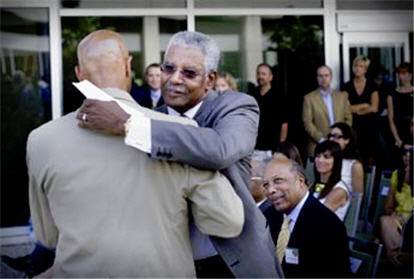
Most people use the Shoulder Tap to break a clinch - sincere huggers hold on tight.
This chapter covers some of the most common head gestures and body language clusters you are likely to see in your day-to-day dealings with others.
The Head Nod
In most cultures the Head Nod is used to signify 'Yes' or agreement. It's a stunted form of bowing - the person symbolically goes to bow but stops short, resulting in a nod. Bowing is a submissive gesture so the Head Nod shows we are going along with the other person's point of view. Research conducted with people who were born deaf, dumb and blind shows that they also use this gesture to signify 'Yes', so it appears to be an inborn gesture of submission.
In India, the head is rocked from side to side, called the Head Wobble, to signal 'Yes'. This is confusing for Westerners and Europeans, who use this gesture to communicate 'Maybe yes - maybe no'. As we've already said, in Japan, head nodding doesn't necessarily mean 'Yes, I agree' - it usually means 'Yes I hear you.'
Head nodding has its origins in bowing to appear subordinate.
In Arab countries they use a single, upward head movement, which means 'no' while Bulgarians use the common 'no gesture to mean 'yes'
Why You Should Learn to Nod
Most people have never considered the power of head nodding as a persuasion tool. Research shows that people will talk three to four times more than usual when the listener nods their head using groups of three nods at regular intervals. The speed of the nod signals the patience - or lack of patience - of the listener. Slow nodding communicates that the listener is interested in what the speaker is saying so give slow, deliberate clusters of three head nods when the other person is making a point. Fast nodding tells the speaker you've heard enough or that you want them to finish or give you a turn to speak.
How to Encourage Agreement
There are two powerful uses of the Head Nod. Body language is an unconscious outward reflection of inner feelings so, if you feel positive or affirmative, your head will begin to nod as you speak. Conversely, if you simply start nodding your head intentionally, you will begin to experience positive feelings. In other words, positive feelings cause the head to nod - and the reverse is also true: nodding the head causes positive feelings. It's cause and effect again.
Head nodding is also very contagious. If someone nods their head at you, you will usually nod too - even if you don't necessarily agree with what they are saying. Head nodding is an excellent tool for creating rapport, getting agreement and cooperation. By finishing each sentence with a verbal affirmation such as, 'Isn't it?', 'Wouldn't you?', 'Isn't that true?' or 'Fair enough?', and with the speaker and listener both nodding their heads, the listener experiences positive feelings which create a greater likelihood of getting them to agree with you.
Head nodding encourages co-operation and agreement.
After you've asked a question and the listener gives his answer nod your head during his answer. When he finishes speaking continue to nod your head another five times at the rate of about one nod per second. Usually, by the time you have counted to four, the listener will begin speaking again and give you more information. And as long as you nod and stay silent with your hand on your chin in an Evaluation position, there's no pressure on you to speak and you won't come across like an interrogator. When you listen, put your hand on your chin and give it light strokes because, as previously stated, research shows that this encourages others to keep talking.
The Head Shake
Research also indicates that the Head Shake, usually meaning 'No', may also be an inborn action and evolutionary biologists believe that it's the first gesture humans learn. This theory says that when the newborn baby has had enough milk, it shakes its head from side to side to reject its mother's breast. Similarly, a child who has had enough to eat uses the Head Shake to reject attempts to spoon feed him.
Shaking the head owes its origin to breastfeeding.
When someone is trying to convince you, watch if they use the Head Shake gesture while saying they agree. The person who says, 'I can see your point of view', or, 'It sounds good', or, 'We'll definitely do business', while shaking his head from side to side might sound convincing, but the Head Shake gesture signals a negative attitude and you would be well advised to be skeptical about it.
No woman believes a man who says 'I love you' while shaking his head. When Bill Clinton uttered his famous phrase, 'I did not have sex with that woman' during the Monica Lewinsky inquest, he did not use a Head Shake.
The Basic Head Positions
1. Head Up
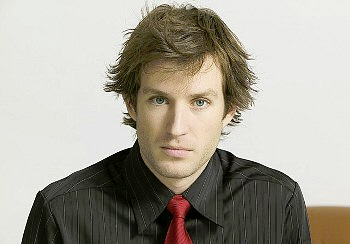
The neutral head position
There are three basic head positions. The first is with Head Up and is the position taken by the person who has a neutral attitude about what is being said. The head remains still and the conversation may be punctuated by occasional small nods. Hand-to-cheek evaluation gestures are often used with this position.

Hillary Clinton using her defiant Chin Thrust
When the head is lifted high with the chin jutting forward it signals superiority, fearlessness or arrogance. The person intentionally exposes their throat and they gain additional height which allows them to 'look down their nose' at you. Large chins are the result of high testosterone levels which is why chin-jutting is associated with power and aggression.
2. The Head Tilt
Tilting the head to the side is a submission signal because it exposes the throat and neck and makes the person look smaller and less threatening. Its probable origin is in the baby resting its head on its parent's shoulder or chest, and the submissive, non-threatening meaning it conveys seems to be unconsciously understood by most people, especially women.

The Head Tilt displays the vulnerable neck and makes a person appear smaller and more submissive
Charles Darwin was one of the first to note that humans, as well as animals - especially dogs - tilt their heads to one side when they become interested in something. Women will use this gesture to show interest in men they fancy because a woman who is nonthreatening and shows submission is attractive to most men.
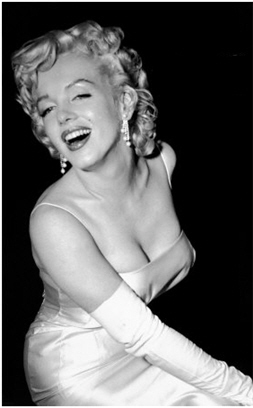
Tilting the head to reveal the vulnerable neck appears to be intuitively understood by most people
Studies of paintings from the last two thousand years show that women are depicted three times as often as men using the Head-Tilt and women are shown in advertisements tilting their heads three times as often as men. This shows how most people understand, on an intuitive level, that displaying the neck shows submission. In a business negotiations with men, however, a woman should keep her head up at all times.
If you are giving a presentation or delivering a speech, make a point of looking for this gesture among your audience. When you see an audience tilting their heads and leaning forward using hand-to-chin evaluation gestures, you're getting the point across. When you listen to others, use the Head-Tilt and Head Nods and the listener will begin to feel trusting towards you because you appear non-threatening.
3. Head Down
When the chin is down, it signals that a negative, judgemental or aggressive attitude exists. Critical evaluation clusters are normally made with the head down and until the person's head lifts or tilts, you can have a problem, professional presenters and trainers are often confronted by audiences who are seated with their heads down and arms folded on their chests.
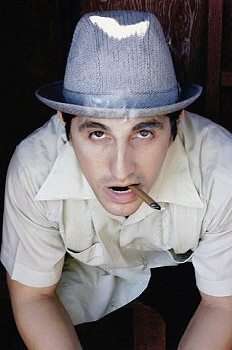
Head Down shows disapproval or dejection
Experienced conference speakers and presenters will take action to involve their audience and get participation before they begin their presentation. This is intended to get the audience's heads up and to get involvement. If the speaker's tactic is successful, the audience's next head position will be the Head Tilt.
The English have a peculiar greeting gesture called the Head Twist, which involves putting the head down while simultaneously twisting the head to one side. This comes from medieval times when men would doff their hat as a form of greeting; this evolved into just dipping the head and touching the hat, which, in modern times, is now the Head Twist, the salute or simply tapping the forehead when meeting someone.
The Head Shrug
Raising the shoulders and pulling the head down between them lets a person protect the vulnerable neck and throat from injury. It's the cluster used when a person hears a loud bang behind them or if they think something will fall on them. When it's used in a personal or business context it implies a submissive apology, which detracts from any encounter where you are trying to appear confident.
When someone walks past others who are talking, admiring a view or listening to a speaker, they pull their head down, turn their shoulders in and try to appear smaller and less significant. This is known as the Head Duck. It is also used by subordinates approaching superiors, and reveals the status and Power play between individuals.

The Head Duck - trying to appear smaller in order not to cause offense to others
Picking Imaginary Lint
When a person disapproves of the opinions or attitudes of others but doesn't want to say anything, displacement gestures are likely to occur, that is, apparently innocent body language gestures that reveal a withheld opinion. Picking imaginary pieces of lint from one's own clothing is one such gesture. The Lint-Picker usually looks down and away from others while performing this seemingly minor, irrelevant action. This is a common signal of disapproval and is a good sign that he doesn't like what's being said, even when he sounds as if he's agreeing with everything.
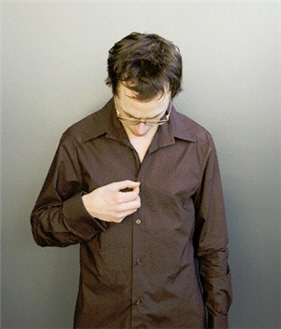
The Lint-Picker has a secret opinion and prefers not to state it
Open your palms and say, 'What do you think?' or, 'I can see you have some thoughts on this. Would you mind telling me what they are?' Sit back, arms apart, palms visible, and wait for the answer. If the person says he is in agreement with you but continues to pick the imaginary lint, you may need to take an even more direct approach to discover his hidden objections.
How We Show We're Ready for Action
To appear bigger for fighting or courting rituals, birds will fluff their feathers, fish can expand their body size by sucking in water and cats or dogs make their fur stand on end. The hairless human, however, no longer has a thick pelt to expand to make himself look more imposing when he is fearful or angry. When we describe a scary movie we often say, 'It made my hair stand on end'; if we become angry with someone, 'He made the hackles on my neck rise'; and when we are smitten with someone, they can give us 'goose bumps'. All these are the body's mechanical reactions to circumstances in which we attempt to make ourselves appear larger and are caused by the erector pillae muscles on the skin, which attempt to make our non-existent fur stand up. Modern humans, however, have invented a gesture to help them achieve a bigger physical presence - the Hands-on-Hips gesture.
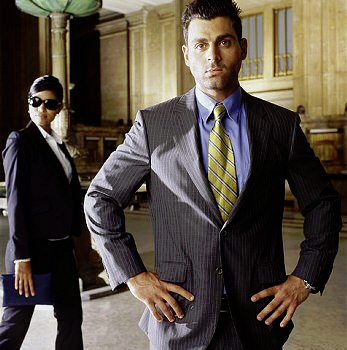
Elbows up and pointed out shows readiness to dominate; elbows in and head tilted show submission
Hands-on-Hips is used by the child arguing with its parent, the athlete waiting for his event to begin, the boxer waiting for the bout to start and males who want to issue a non-verbal challenge to other males who enter their territory. In each instance the person takes the Hands-on-Hips pose and this is a universal gesture used to communicate that a person is ready for assertive action. It lets the person take up more space and has the threat value of the pointed elbows that act as weapons, preventing others from approaching or passing. The arms being half raised show readiness for attack and this is the position taken by cowboys in a gunfight. Even one hand on the hip will send the intended message, particularly when it's pointed at the intended victim. It's used everywhere and in the Philippines and Malaysia it carries the even stronger message of anger or outrage.
Also known as the 'readiness' gesture, that is, the person is ready for assertive action, its basic meaning carries a subtly aggressive attitude everywhere. It has also been called the achiever stance, related to the goal-directed person who is ready to tackle their objectives or is ready to take action on something. Men often use this gesture around women to display an assertive male attitude.
Hands-on-Hips makes you look bigger and more noticeable because you take up more space.
It's important to consider the context and other body language immediately preceding the Hands-on-Hips pose in order to make an accurate assessment of the person's attitude. For example, is the coat open and pushed back on to the hips, or is it buttoned when the aggressive pose is taken? Closed-Coat Readiness shows frustration, whereas coat open and pushed back is directly aggressive because the person is openly exposing their front in a display of fearlessness. This position is further reinforced by placing the feet evenly apart on the ground or by adding clenched fists to the gesture cluster.

Hands-on-Hips used by models to make clothing more appealing
These aggressive-readiness clusters are used by professional models to give the impression that their clothing is for the modern, assertive, forward-thinking woman. Occasionally the gesture may be done with only one hand on the hip and the other displaying another gesture and this is commonly used by women who want to draw attention to themselves by using this cluster with a pelvic tilt to emphasize their hips-to-waist ratio, which indicates fertility. Hands-on-Hips is regularly used by both men and women in courtship to draw attention to themselves.
The Cowboy Stance
Thumbs tucked into the belt or into the tops of the pockets, frames the genital area and is a display used mainly by men to show a sexually aggressive attitude. It is the most common gesture used in television Westerns to show viewers the virility of their favorite gunslinger.

The cowboy stance - his fingers point at what he wants you to notice
Also jokingly called the Man-of-the-Long-Thumbs gesture, the arms take the readiness position and the hands serve as central indicators, highlighting the genitals. Men use this gesture to stake their territory or to show other men that they are unafraid. Apes use the same gesture, but without a belt or pants.
This gesture tells others, 'I am virile - I can dominate' which is why it's a regular for men on the prowl. Any man talking to a woman while he's standing like this - with dilated pupils and one foot pointing towards her - is easily read by most women. It's one of the gestures that gives the game away for most men, as they unwittingly declare to her what's on their mind.

The sexually assertive female
This gesture is principally used by men, but women wearing jeans or pants can occasionally be seen doing it too. When wearing dresses or skirts, the sexually assertive female displays one or both thumbs tucked into a belt or pocket.
Sizing Up the Competition
The next image shows two men sizing each other up, using the characteristic Hands-on-Hips gesture. They face each other directly, standing straight and looking serious. We might assume from this collective posture that they are unconsciously evaluating each other while perhaps discussing an important matter.
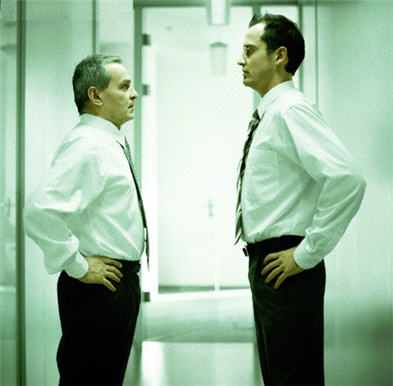
Sizing up the competition
Their conversation may not overtly sound strained but a relaxed atmosphere won't exist until their Hands-on-Hips gestures are dropped and more open gestures are used.
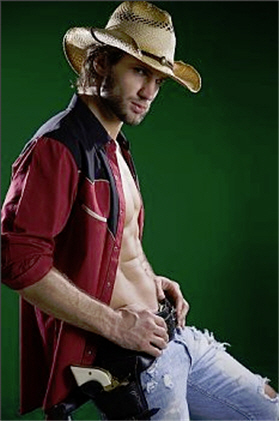
Gesture clusters show aggressive attitudes
Even though Adolf Hitler used the Hands-on-Hips gesture to try to appear authoritative for publicity photographs he still could not stop his left hand from crossing his body and attempting to cover his solitary testicle.
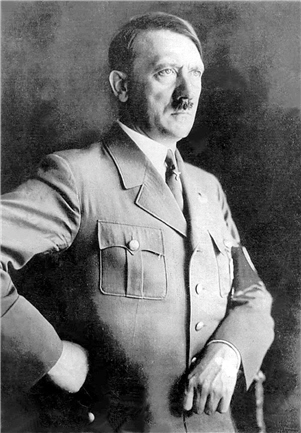
Contradictory signals: his right arm shows pointed aggression while his left hand attempts to protect his front
The Legs-Spread
This is almost entirely a male gesture and is also seen among apes who are trying to establish authority over other apes. Rather than risk injury fighting, they spread their legs and the one with the biggest display is seen as the most dominant. And so it is with male humans; even though it's usually done unconsciously, it sends a powerful message. If one man does the Legs-Spread the others usually mirror to maintain status but it has very negative effects when a man uses it in front of women, especially in a business context, because she can't mirror it.
A woman will feel intimidated by a man who uses the Legs-Spread in business situations.
Research videos taken at a number of meetings reveal that many women respond by crossing their legs and arms, which immediately puts them on the defensive. The advice for men here is clear - keep your legs together in business meetings. If you are a woman who is constantly confronted by a man who emphasizes his pelvis, unconsciously or consciously, do not react when he does it. It can work against you only if you respond defensively. Instead, try talking to his pelvis indirectly - responses such as 'You've got a good point there, Max' and 'I can see where you're coming from' can teach a valuable lesson as well as causing riotous laughter when used at the right time.
Leg-Over-the-Arm-of-Chair
This is mainly done by men because it also uses the Legs-Spread. It not only signifies the man's ownership of the chair, it also signals that he has an informal, aggressive attitude.
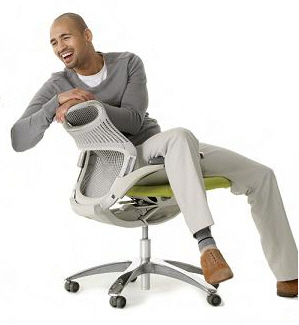
Informality, indifference, and lack of concern
It is common to see two male friends laughing and joking with each other while sitting this way, but let's consider its impact in different circumstances. Let's say an employee has a personal problem and goes to ask his boss for advice. As the employee explains, he leans forward in the chair, his hands on his knees, his head down, with a dejected expression and voice lowered. The boss listens, sitting motionless, then leans back in his chair and puts one leg over the arm. The boss's attitude has now changed to lack of concern or indifference. In other words, he has little concern for the employee or his problem and he may even feel that his time is being wasted with the "same old story".
So what was the boss indifferent about? He may have considered the employee's problem, decided that it's not much of a problem anyway and become disinterested. He may even tell his employee not to worry and that the problem will simply go away
As long as the boss's leg stays over the arm of the chair, his indifferent attitude will persist. When the employee leaves the office, the boss breathes a sigh of relief and says to himself, 'Thank heavens he's gone!' and takes his leg off the arm of the chair.
The Leg-Over-the-Arm-of-Chair can be annoying when it occurs during negotiation, and it is vital to make that person change position because the longer he stays in it, the longer he will have an indifferent or aggressive attitude. An easy way to do this is to ask him to lean across and look at something, or, if you have a wicked sense of humor, tell him there's a split in his pants.
Straddling a Chair
Centuries ago, men used shields to protect themselves from the spears and clubs of the enemy, and today, civilized man uses whatever he has at his disposal to symbolize this same protective behavior when he is under physical or verbal attack. This includes standing behind a gate, doorway, fence, desk or the open door of his motor vehicle and straddling a chair.
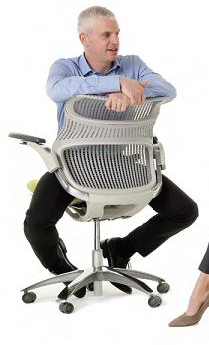
The Straddler wants to dominate or control while, at the same time, protecting his front
The back of the chair acts as a shield to protect the body and can transform a person into an aggressive, dominant personality. Men also have their legs spread in a wide Pelvic Display, adding male assertion to the position. Most Straddlers are dominant types who will try to take control of others when they become bored with the conversation, and the back of the chair serves as good protection from any 'attack' by other members of the group. The Straddler is often discreet and can slip into the straddle position almost unnoticed.
The easiest way to disarm the Straddler is to stand up or sit behind him, making him feel vulnerable to attack and forcing him to change his position. This can work well in a group situation because the Straddler will have his back exposed and this compels him to change to another position.
So what would you do with a Straddler on a swivel chair? It is pointless to try to reason with a genital-displaying man on a merry-go-round, so the best defense is non-verbal. Conduct your conversation standing up and looking down on the Straddler, and move into his Personal Space. This is unnerving for him and he can even fall backwards off his chair in an attempt to move away.
Next time you have a Straddler coming to visit you, be sure to seat him on a fixed chair that has arms to stop him from taking his favorite position. When he can't straddle, his usual next move is to use the Catapult.
The Catapult
This is a seated version of the Hands-on-Hips pose except the hands are behind the head with the elbows menacingly pointed out. Again, it's almost entirely a male gesture used to intimidate others or it infers a relaxed attitude to lull you into a false sense of security just before he ambushes you.

Cool and Confident
This gesture is typical of professionals such as accountants lawyers, sales managers or people who are feeling superior dominant or confident about something. If we could read this person's mind, he would be saying things such as, 'I have all the answers', or 'Everything's under control', or even 'Maybe one day you'll be as smart as me'. Management personnel regularly use it and newly appointed male managers suddenly begin to use it, despite the fact that they seldom used it prior to their promotion. It is also used by 'Know-It-All' individuals and it intimidates most people. It's the trademark gesture of men who like you to realize just how knowledgeable they are. It can also be used as a territorial sign to show that the person has staked a claim to that particular area.
It is usually clustered with a Figure-Four leg position or Pelvic Display, which shows that he not only feels superior, he is also likely to argue or try to dominate. There are several ways you can deal with this gesture, depending on the circumstances. You can lean forward with palms up and say, 'I can see that you know about this. Would you care to comment?' then sit back and wait for an answer.
Women quickly develop a dislike for men who use the Catapult in business meetings.
You could place something just out of his reach and ask, 'Have you seen this?', forcing him to lean forward. If you are a man, copying the gesture can be a simple way to handle the Catapulter because mirroring creates equality. This doesn't work for a woman however, because it puts her breasts on display, leaving her at a disadvantage. Even flat-chested women who attempt the Catapult are described as aggressive by both men and women.
The Catapult doesn't work for women, even flat-chested ones.
If you are a woman and a man does this, continue the conversation standing up. This forces the Catapulter to change position so he can continue the conversation. When he stops the Catapult, sit down again. If he catapults again, stand up. This is a non-aggressive way of training others not to try to intimidate you. On the other hand, if the person using the Catapult is your superior and is reprimanding you, you will intimidate him by copying this gesture. For example, two equals will use the Catapult in each other's presence to show equality and agreement. If a mischievous student tries it however while the school principal is exercising his / her authority, it would often provoke a stern response.
In research at one insurance company, it was found that 27 out of 30 male sales managers used the Catapult regularly around their salespeople or subordinates but rarely in the presence of their superiors. When they were with their superiors, however, the same managers were more likely to use submissive and subordinate gesture clusters.
Gestures That Show When a Person is Ready
One of the most valuable gestures a negotiator can learn to recognize is seated readiness. When you are presenting a proposal, for example, if the other person were to take this gesture at the end of the presentation, and the interview had gone well up to that point, you could ask for agreement and would be likely to get it.
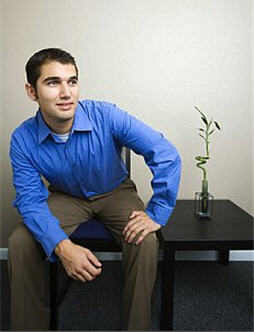
The classic position showing readiness for action
Our video replays of salespeople interviewing potential buyers revealed that, whenever the Seated Readiness gesture followed a Chin-Stroke (decision-making), the client said 'yes' to the proposal more than half the time. In contrast, if during the close of the sale the client took the Arms-Crossed position immediately after the Chin-Stroke, the sale was usually not made. The Seated Readiness gesture can also be taken by the angry person who is ready for something else - to throw you out. The preceding gesture clusters indicate the person's real intentions.
The Starter's Position
Readiness gestures that signal a desire to conclude a meeting or engage in a wholly new task include leaning forward with either or both hands on knees, or leaning forward with hands gripping the chair as if they were at the start of a race. If either of these occur during a conversation, consider finishing up and closing the conversation or re-orienting the direction to complete any unfinished matters.
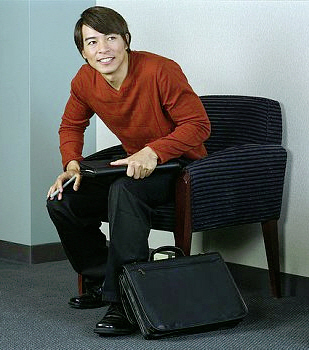

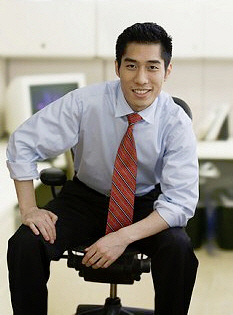
On your marks, get set, ... these gentleman are in the starting blocks, ready to jump into a new task or personal interaction
Summary
The body language signals covered in this chapter are fairly easy to observe because most involve big gestures. Not only is it important to understand the significance of these signals, it's vital to good communication that you eliminate any negative gestures from your own repertoire and practice using the things that will give you positive results.



